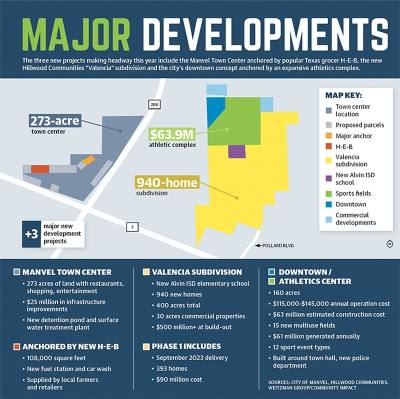Some of the key new developments making headway this year include a nearly 1,000-home housing development from real estate developer Hillwood Communities in the heart of the city, a new shopping center anchored by popular grocery chain H-E-B, and plans for a municipal center and an athletic center.
City officials said they believe the major developments are laying the groundwork for the future continued success of the city and accommodating its growing population.
“I believe that the reason why we have so many people wanting to join this community is because they want to be a part of what the future holds,” Council Member and mayoral candidate Lorraine Hehn said. “All the other cities have to fight to get people at the table. Here, we’ve never had to for a long time.”
Population boom
The city of Manvel has seen a 137.7% population growth in the past decade. In 2010, the U.S. Census Bureau’s American Community Survey data showed a population of 11,432 in 2020 versus 4,810 in 2010.
Manvel City Manager Kyle Jung said keeping up with population projections and meeting citizen demands for new infrastructure and utilities can be a challenge. He said in 2007 the city did a comprehensive study that predicted an entirely built-out city of Manvel, which comprises about 27.45 square miles, would be able to hold a population of 120,000-150,000 people.
“We did the master water and wastewater plans in 2017, and we blew through all the 20-year projections,” Jung said. “Last year, we had to redo them. We had to update all those numbers because it went faster than we thought it was going to, which is not a bad thing.”
The city attempted to be proactive with its thoroughfare plan; city officials said they were advised by nearby municipalities to focus on connectivity and intuitive traffic flow to avoid “chokepoints.”
“This amount of development gives you huge growing pains, ... but you need to be able to learn from others’ mistakes,” Manvel Mayor Debra Davison said. “That’s where our thoroughfare plan came into play: We didn’t want [one main thoroughfare] completely governing where our traffic goes, you know, for the rest of time,”
Jung said much of the city’s evolving thoroughfare plan from 2015 coincides with the city’s major developments, including the Hillwood housing development called Valencia, located at the north end of Pollard Avenue. Some of the main focuses of the city’s thoroughfare improvements include upgrades to the Hwy. 288 corridor, specifically through adding more convenient access points.
“The Valencia development is kind of a key. It’s a lynchpin area for some of the development on [FM 1128 and Hwy. 288],” Jung said.
The biggest projects
Valencia broke ground in May 2022 and is expected to deliver its Phase 1 homesites by September, Hillwood Marketing Manager Lori Evans. The $90 million Phase 1 includes 393 homes, and home sales are expected to start in January 2024, she said.
Upon completion, the community is expected to bring 940 single-family homes with 30 acres of dedicated commercial properties as well as a new Alvin ISD school. The projected construction value will be over $500 million at completion, Hillwood Houston General Manager Russell Bynum.
This 400-acre development follows the opening of the Pomona subdivision, another Hillwood housing development off Hwy. 288. Pomona opened in 2015 with 600 of its projected 2,100 homes, and the development is about 58% complete, according to the city’s capital projects webpage.
“Last year we issued almost 1,000 new home permits,” Jung said. “My guess is that we will probably either slow down a little bit or keep about that same amount [yearly].”
Meanwhile, on the west side of the Hwy. 288 and Hwy. 6 intersection lies the site of the upcoming Manvel Town Center development, on which developer Weitzman broke ground June 22, 2021.
Phase 1 of the 273-acre project hinges on the city’s first H-E-B, which is the anchor of the expansive commercial development, or the primary economic draw that attracts other tenants to the area. The new H-E-B is expected to open in late summer, Jung said.
“Most of the other contracts that they have are dependent upon H-E-B opening,” Jung said. “You know, this store over here wants to make sure [H-E-B] is going to bring all the people to their parking lot.”
Davison said contracts for other “junior anchors” are not yet solidified for the development, mentioning Lowe’s and Target as examples for other retail locations that could be attracted by the new H-E-B. Jung also said the city held preconstruction meetings with McDonald’s and Whataburger for the area.
Finally, city officials highlighted a proposed future downtown area adjacent to Valencia that would feature a new city hall and main city service buildings and an expansive sports complex. The 160-acre area would feature a series of multiuse sports fields alongside retail space for hotels, an amphitheater and other community spaces, according to a Dec. 5 feasibility study for the project.
The study, conducted by The Sports Facilities Advisory for architecture design client PGAL, shows an estimated investment of $63.9 million from the city for the complex, which has no stated timeline yet.
Current council officials touted the project as an opportunity to create a sports tourism destination that will attract visitors from across the state, boosting the local economy and providing a walkable downtown space for current residents.
Davison said the project, which had its design recently approved and may see ground work start in the summer, is facing some criticism from citizens and council candidates.
“For a period of time, [taxes] would in fact, admittedly, go up, but it would also come right back down,” she said. “Whatever the first building that goes in [the development] will be the most expensive because you have to build the road to get to it, and therefore it’s a process.”
Redefining rural
While the new developments are intended to capitalize on the city’s growth and service the new population’s needs, city officials have acknowledged criticisms from some of Manvel’s citizens that may see the rapid changes as a threat to the city’s small-town rural identity.
In an online survey conducted mid-March on the Community Impact website, some residents expressed disapproval with the city’s growth. Respondents shared concerns with increased taxes and traffic, with some saying that rapid development could be overwhelming.
“While development and growth is necessary, too much, too fast can end up choking the heart out of the city,” Manvel resident Tish Raiford said in the survey.
Former Council Member and current mayoral candidate Dan Davis said the growth should remain methodical and considerate. He said residents want the city to remain rural in nature.
“There’s ditches in our city that haven’t been mowed in 40 years; there’s roads that constantly are getting potholes because of the traffic ... [and] things that have been neglected for the sake of growth,” Davis said.
However, of the 28 responses Community Impact received in the seven-day period, more than 70% generally support the growth.
“[I’m] looking forward to not having to go to Missouri City or Pearland to shop and have eating options much closer to home,” Manvel resident Frank Boley said in the survey.
Longtime resident Harry Opliger said Manvel maintains its rural atmosphere despite the city’s rapid development process. He described the part of town he lives in as “Old Manvel,” where he bought several acres of land to build his home.
“Just this morning I woke up, looked out the back, and somebody’s cows were walking around the neighbor’s yard,” he said. “It’s country life, and that’s what makes this town so neat and diverse.”
Opliger said he is satisfied with the development he has seen in the 23 years he has been a resident.
“I think good times are ahead of us,” he said. “You know, it just takes a little bit more work—more refining of the processes, you know. Got to work out some of these growing pains, as with any growth is growing pains.”







